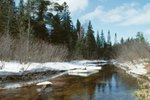
Beavers in Alberta, Canada give new meaning to the phrase "busy as a beaver." These rodents' dam, which a researcher discovered unintentionally in 2007, is the largest beaver dam in the world. Although this dam sets the record, many other beavers' structures are impressive in their design and size. Beavers are second only to humans as the living beings most capable of changing their environment.
Location
The biggest beaver dam in the world sits in a remote area of Wood Buffalo National Park in northern Alberta, Canada. It is nestled in dense forests and marshlands about 120 miles northeast of Fort McMurray. Jean Thie, a Canadian ecologist, was using Google Earth and NASA satellite images when he located the dam while he was researching how quickly permafrost was melting. The dam is visible from outer space. Beaver dams are some of the only structures made by animals that can be seen from space. Coincidentally, the beaver is Canada's national symbol.
Purpose
Beaver dams serve as habitats for these mammals, and they also provide protection from predators. The dam design forms pools of water that create passageways for food and building materials. Also, the dam causes water to back up so it freezes only on the surface in the winter. Thus beavers can keep their food, such as stick bark and water plants, under the water year round. Animals other than beavers, such as fish, ducks, frogs, herons and turtles, use the ponds created by dams as their habitats.
Characteristics
The biggest beaver dam in the world is about 2,800 feet long, which is roughly the same length as eight football fields. By contrast, typical beaver dams measure between 32 and 320 feet long. Dams consist of tree logs, branches, twigs and mud. Several generations and numerous families of beavers have been building the massive structure in Canada since the middle of the 1970s. Scientists can tell how old it is not only by its vast size, but also by observing and dating its materials. Lush vegetation such as green grass surrounds and covers the dam structure.
History
Before Thie discovered the dam in Alberta, Canada, and it was dubbed the biggest in the world, a dam in Three Forks, Montana, measuring more than 2,100 feet, held the record for the world's largest. Beavers are making a comeback and repopulating various areas of Canada where their ancestors previously lived, after centuries of being hunted.
Expansion
Beavers continue to add to the huge dam they've already built in Alberta, Canada, so its size is growing over time. A smaller dam sits near each end. In the future, all three of these dams might be connected with one another. This would make the impressive structure that much larger.
References
- Discovery Communications: Largest Beaver Dam Seen from Space
- The Telegraph: World's Biggest Beaver Dam Can Be Seen from Space
- NBC News: Biggest Beaver Dam Seen from Space
- BBC News: 'World's Biggest' Beaver Dam Discovered in Canadian Park
- National Geographic: Beaver Castor canadensis
- Beavers: Wetlands & Wildlife: About Beavers
Resources
- Adirondack Ecological Center: Beaver (Castor canadensis Kuhl)
- The Kids' Wildlife Book; Warner Shedd
Photo Credits
-
Robert Byron/Hemera/Getty Images
Writer Bio
Judy Wilson has writing and editing expertise in health, technology, pets, business and travel. She has contributed to USAToday.com, SFGate.com and numerous other publications. Wilson earned a Bachelor of Arts in journalism and mass communication from the University of North Carolina at Chapel Hill, where she completed Mini Medical School.




